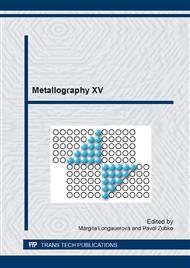p.3
p.8
p.16
p.23
p.31
p.41
p.45
p.51
p.57
Modern Self-Lubricating Coatings for Automotive, Aviation and Spacecraft Industry
Abstract:
A series of nanocomposite, self-lubricating coatings designed for dry friction at different temperatures based on amorphous carbon or amorphous MoS2 or amorphous MoO3 matrix was deposited by magnetron sputtering onto high-speed (HS) steel or Ti6Al4V alloy substrates and characterized with use of LM, SEM, TEM and HRTEM microscopy as well as with use of several other techniques. The nanocomposite nc-MeC/a-C(:H) carbon-based coatings (where Me=Cr or Ti or W) were composed of different nanocrystalline phases of a given transition metal of a size of several nanometers embedded in an amorphous hydrogenated or hydrogen-free carbon matrix. The nanocomposite MoS2(Ti,W) coatings were composed of Tiα or Wα or TiS2 nanocrystallites of 3 nm ÷ 10 nm diam. embedded in a semi-crystalline MoS2 matrix with MoS2 clusters of 3 nm÷8 nm diam. The magnetron sputtered MoO3 based coatings after deposition were composed of Ag nanocrystallites of 50 nm÷100 nm diam. embedded in an amorphous fractal-type matrix composed of MoO3 clusters of different size from very small to relatively great ones (not exceeding, however, 400 nm diam.). These amorphous clusters after 3 hours annealing in the ambient atmosphere under normal pressure at 300 °C transform into nanocrystalline MoO3 ones or after same annealing at 450 °C into crystalline silver molybdate Ag2MoO4 ones. The coatings preserve their resistance to wear and their low friction coefficient to approximately 250 °C in case of carbon-based coatings or to 350 °C in case of MoS2-based ones or to 550 °C in case of MoO3-based coatings. Several mechanical and tribological chracteristics of the coatings are given in the paper as well.
Info:
Periodical:
Pages:
31-38
Citation:
Online since:
April 2014
Price:
Сopyright:
© 2014 Trans Tech Publications Ltd. All Rights Reserved
Share:
Citation:


